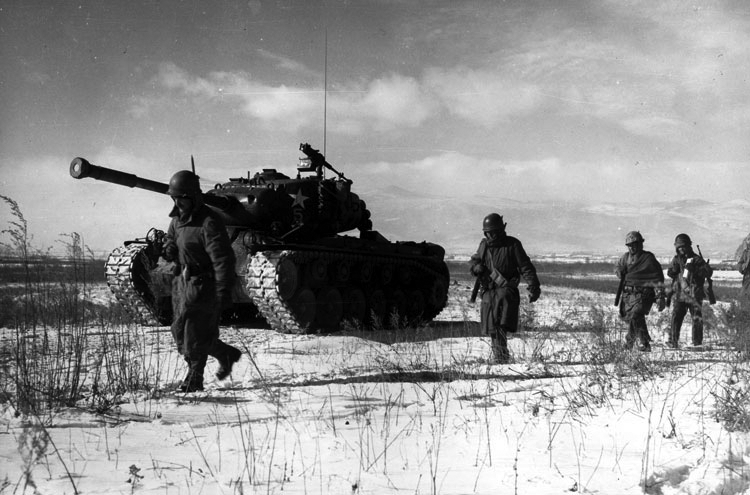
A column of troops and armor of the 1st Marine Division move through communist Chinese lines, and this was during their successful breakout from the Chosin Reservoir in North Korea in 1950. Photo by Corporal Peter McDonald, USMC – [1] (originally uploaded to en.wiki by Raul654)
The Department of Veterans Affairs (VA) has expanded and clarified its internal guidance for evaluations of veteran cold injury, and most of all, these changes include an update to the chronic effects of exposure to 20 conditions.
Especially relevant, the November 29, 2016 change in the M21-1 Adjudication Procedures Manual include:
- Addition of chronic fungal infection of the nails
- Addition of distortion and loss of nail to nail growth disturbances
- Reminder that continuity of symptoms is not needed following a cold injury. Signs and symptoms may reoccur after a long symptoms free period of time
- Acknowledgement that service treatment records (military medical records) may not document a cold injury.
As a result, veteran cold injury now includes these chronic effects of exposure:
- chronic fungal infection of the feet or nails
- disturbances of nail growth (including distortion or loss of the nail)
- hyperhidrosis
- chronic pain of the causalgia type
- abnormal skin color or thickness
- cold sensitization
- joint pain or stiffness
- Raynaud’s phenomenon
- weakness of hands or feet
- night pain
- weak or fallen arches
- edema
- numbness
- paresthesias
- breakdown or ulceration of cold injury scars
- vascular insufficiency, indicated by edema, shiny, atrophic skin, or hair loss, and
- increased risk of developing conditions, such as
- peripheral neuropathy
- squamous cell carcinoma of the skin, at the site of the scar from a cold injury, or
- arthritis or other bone abnormalities, such as osteoporosis, or subarticular punched-out lesions.
Lay evidence will be accepted if consistent with the “circumstances, conditions or hardships of combat service,” while even if not corroborated with service treatment records but the cold injuries were related to documented combat service.
Two example combat service campaigns are:
- Battle of the Bulge (Ardennes/Rhineland) in the winter of 1944 – 1945 [December – January]
- The Chosin Reservoir Campaign, October – December 1950
The VA confirms veteran participation in a Campaign and concedes exposure to extreme cold under Title 38, United States Code, Section 1154(a). As a result, the VA grants a service connection for cold injuries because of the provisions of Title 38, Code of Federal Regulations, Sections 3.303(a) and 3.304(d). In addition, it is important to remember that the VA will always look for other circumstances to which the claimed disability may be attributed.
Disability Ratings
Title 38, Code of Federal Regulations, Section 4.104, (VA Diagnostic Code 7122) is the authority, and provides disability evaluations and ratings:
| 7122 Cold injury residuals: | |
| With the following in affected parts: | |
| Arthralgia or other pain, numbness, or cold sensitivity plus two or more of the following: tissue loss, nail abnormalities, color changes, locally impaired sensation, hyperhidrosis, X-ray abnormalities (osteoporosis, subarticular punched out lesions, or osteoarthritis) | 30 |
| Arthralgia or other pain, numbness, or cold sensitivity plus tissue loss, nail abnormalities, color changes, locally impaired sensation, hyperhidrosis, or X-ray abnormalities (osteoporosis, subarticular punched out lesions, or osteoarthritis) | 20 |
| Arthralgia or other pain, numbness, or cold sensitivity | 10 |
| Note (1): Separately evaluate amputations of fingers or toes, and complications such as squamous cell carcinoma at the site of a cold injury scar or peripheral neuropathy, under other diagnostic codes. Separately evaluate other disabilities that have been diagnosed as the residual effects of cold injury, such as Raynaud’s phenomenon, muscle atrophy, etc., unless they are used to support an evaluation under diagnostic code 7122. | |
| Note (2): Evaluate each affected part (e.g., hand, foot, ear, nose) separately and combine the ratings in accordance with §§4.25 and 4.26. |
Medical Evidence
The VA requires medical evidence confirming whether or not x-ray abnormalities exist (osteoporosis, subarticular punched out lesions, or osteoarthritis). Due to this requirement, the VA uses the Cold Injury Residuals Disability Benefit Questionnaire (DBQ) to document a cold injury residual examination and provides confirmation of x-rays as required.
Of note: Private providers cannot use the Cold Injury Residuals DBQ. As a result, a VA provider gives the veteran a mandatory disability compensation examination.
Especially relevant, the VA explains why the DBQ is not available for public use:
“VA has determined that the examinations required to complete those DBQs either require specialized training, specialized equipment, or specialized testing generally not available through private providers, or, if these examinations are available, the cost to the Veteran would be so great as to render the DBQ cost-prohibitive. For these reasons, VA has determined that it is in the Veteran’s best interest to still require these examinations to be conducted by a VA clinician.”
References
- VA Adjudication Procedures Manual, M21-1, Part III, Subpart iv, Chapter 4, Section E
- Unavailability of the Cold Injury Residuals Disability Benefits Questionnaire: http://www.benefits.va.gov/COMPENSATION/dbq_FAQS.asp
- Title 38, United States Code, Sections 1154(a) and (b)
- Title 38, Code of Federal Regulations, Sections 3.303(a), 3.304(d), 4.104
